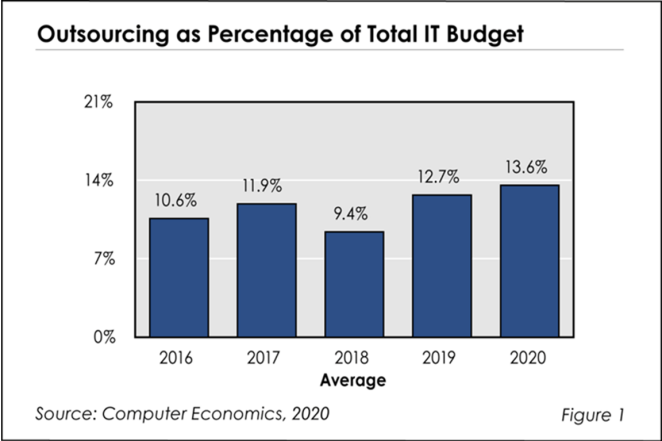IT outsourcing continues its rise. This year, the average percentage of the total IT budget that organizations are spending on outsourcing is at a five-year high, according to the new IT Outsourcing Statistics 2020-2021 study from Computer Economics. This represents the fourth year out of five that the average has risen. This Research Byte summarizes the factors behind the jump in IT outsourcing this year.
As shown in Figure 1 from our full study, the percentage of the total IT budget being spent on outsourcing increased from 12.7% in 2019 to 13.6% in 2020. Not only is this a healthy increase, but it continues a five-year trend toward increased outsourcing (with 2018 being an outlier).

One potential reason is that companies are simply more comfortable with handing over more of their work to service providers. The cloud transformation has been well under way for the past few years. More companies are adopting software as a service (SaaS) and increasing their use of the public cloud. While not all of this fits under our definition of outsourcing, these cloud services are likely making companies more comfortable with putting their fate, not to mention their data, in the hands of service providers.
“A lot of IT organizations are tired of driving things that don’t give the business a competitive advantage,” said David Wagner, senior research director for Computer Economics, a service of Avasant Research, based in Los Angeles. “They’re ready to let someone else take the wheel so they can focus on things that are more strategic.”
Here are other key findings from our IT Outsourcing Statistics study this year:
-
- Application development outsourcing has increased the most in terms of frequency, which is the percentage of companies outsourcing a particular function. About 60% of companies now outsource at least some of their application development, compared with 56% last year. Application developers tend to be expensive, especially if they specialize. Supplementing internal resources can often save money.
- Network operations outsourcing has dropped the most in terms of the percentage of companies outsourcing this function. In 2019, 34% of companies outsourced at least some of their network operations, compared with 27% in 2020. Last year, network operations showed the highest increase.
- Application development is the most frequently outsourced function in the study. Around 60% of organizations outsource some or all of this function. Application development continues to take larger parts of the IT budget, and many IT organizations are looking to get more out of their internal staff through selective use of outside development firms. Demand for application developers can vary significantly from year to year as new development projects are initiated and completed. The use of outsourced development groups, therefore, is a good choice to manage this variable demand.
- IT security outsourcing is showing the largest growth rate of all outsourced functions in terms of the percentage of work outsourced, with a net 55% of respondents reporting that they will increase the amount of security work that they outsource. With the constant coverage of high-profile security and privacy breaches and rising variety of threats, it is no surprise that IT organizations are using security service providers to bolster their defenses.
- Disaster recovery, database administration and desktop support are the top IT functions for reducing costs through outsourcing. The economies of scale that service providers offer make these areas good opportunities for cost savings.
- The functions with the greatest potential for improving service through outsourcing are IT security and disaster recovery. Since both of these areas have to do with managing risk, the motivation to outsource has less to do with saving money and more to do with having the job done better than it can be done in-house.
- The outsourcing of disaster recovery delivers the best value when looking at both cost and service delivery. Disaster recovery, application management, and database administration are the only functions that have a high cost-success and service-success rating. For other areas, there is generally a trade-off between saving money and improving service levels.
In the full study, we profile outsourcing activity for 11 IT functions: application development, application management, data center operations, database administration, desktop support, disaster recovery services, help desk services, IT security, network operations, system implementation/integration, and web operations.
For each IT function, we measure the frequency and level of outsourcing. We also look at the current plans of IT organizations to increase or decrease the amount of work they outsource. Finally, we examine the customer experience to assess whether organizations are successfully lowering costs or improving service through outsourcing.
This Research Byte is a brief overview of our report on this subject, IT Outsourcing Statistics 2020-2021. The full report is available at no charge for Avasant Research subscribers, or it may be purchased by non-subscribers directly from our website (click for pricing).

